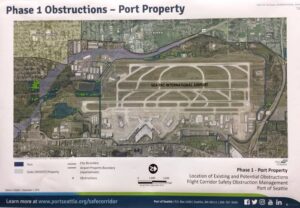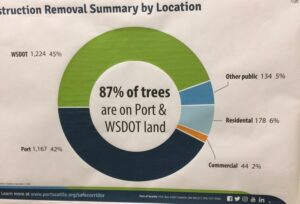Tuesday meeting draws a crowd
By Gwen Davis
The Port of Seattle finally held a public meeting regarding the nearly 3,000 trees it will cut down. The meeting took place Tuesday evening at Bow Lake Elementary. More than 100 people attended, along with a handful of elected officials.
In the first part of the program, five stations were set up detailing the project, name the Flight Corridor Safety Program. The stations discussed the project from several perspectives, including how the plan related to Federal Aviation Administration (FAA) regulations, and the trees and shrubs that will be planted in the trees’ place. Two Port representatives manned each station, and talked to attendees. The stations also featured charts and diagrams regarding the plan.
The Port’s presentation:
In the second half of the program, all participants sat in the school’s gymnasium, and viewed the Port’s PowerPoint presentation of the plan, which was displayed on two large screens. A panelist of Port commissioners was seated at the front.
“We haven’t been good about public engagement, and that’s why we’re here tonight,” Lance Lyttle, Sea-Tac Airport Managing Director began.
“We are here today because we want to listen, we want to engage and we want to answer questions,” Lyttle continued. “We want a safe airport, and we want to mitigate any impact we’re having on people and the environment. If we view each recommendation as being right or wrong, we won’t get to the end state. On the other hand, if we view our or your point of view as options, that will get to a better place. As we present the options today, [let’s] view recommendations not as wrong or right, but as alternatives.”
Lyttle opened with a personal story about how he personally went to lengths to save a single tree. “Taking down trees is not something we take lightly,” he said. “We want to leave the environment in better condition than it is in currently.”
A Port staff member walked the audience through the presentation.
Why the need for the Flight Corridor Safety Program? When planes land, they need an ample amount of space in case of unforeseen problems, such as bad weather or equipment failure. Currently, trees surrounding the airport are too tall and can inhibit safe landing. The removal of obstructions is the Port’s responsibility, the commissioner said. In the past, the FAA reviewed airports’ obstructions, but now the airports themselves need to manage obstructions. A Port
staff member talked about the technology that was used to determine which trees were obstructions. In June, a pilot reported that the trees were too tall, the presentation noted.
A total of 87 percent of the trees to be removed are on Port and WSDOT land. In phase one, trees will be taken down on Port property only. It will cost $3.2 million. The end of the third and final phase will be completed by 2019.
“We did an environmental review only to identity reactions for phase one,” a Port staff member said.
A State Environmental Policy Act (SEPA) was implemented for phase one, the presentation explained. SEPA issued a determination that environmental impact was of non-significance and no further environmental reviews are necessary (however the City of SeaTac has appealed that decision).
Greenhouse gas emissions were analyzed, and SEPA determined that the trees cut in phase one would not cut into air quality significantly. The trees in the wetlands will be removed by hand. For each tree to be removed, four trees will be planted. In steep slopes, stumps will be left to reduce erosion.
“One of the main reason why we’re not topping trees is because it attracts raptors, creates disease and delays natural regrowth,” a commissioner said. The topped trees may become hazardous, and the Port would have to go in and disturb the site again and again. Tree thinning poses the same risks. It invites invasive species, and may require more disturbance to the site in the future.
The names of the species removed were discussed, as well as the species that will be planted.
“I want to give you an idea of how quickly this stuff revegetates,” a Port staff member said. He displayed a slide that provided a picture of full growth that took place just after five years.
“We are committed to a five-year program to make sure [the replanted trees are growing well],” he said.
However, there will be potential for some die-off, which is why four trees will be planted per tree, not just one.
Engagement with the public has not been ideal, a commissioner said, which is why the Port put so much effort into creating the meeting.
“As we go forward, we want to emphasize that we will focus on partnerships, such as WSDOT,” a Port staff member stated. “We look forward to doing that.”
Public comments:
The commissioners then heard public testimony from citizens. Public comment was limited to three minutes.
“I’ve lived here for over 16 years,” the first testifier began. “I worked in the environmental consultant business, and am here as both a professional and resident. I think this [should be] a win-win, as opposed to another third runway fiasco.” He said that the Port failed to tell the public why this is so important, and why is this being done now, not in the past. The link between the FAA and this plan has not been well connected. “I can’t make the link between the documentation and [the plan].” He also asked about why the Port couldn’t light up the trees as opposed to cutting them down.
“You have to forgive us if we’re just a little skeptical,” another testifier said. She noted that the third runway was not accurately portrayed. “My feeling is you want more flights to the airpot. I’d like to encourage you to think about what you’re doing to our community. Now you want to destroy something that’s an integral part of our community that can’t be replaced. The Port is very good at giving slick presentations that don’t always turn out the way they are presented.”
Her presentation was followed by applause.
“SeaTac is not alone in airpots in the country that have obstructions,” another testifier said. But he noted that the Port’s presentation materials may be misleading, such as the charts. It might be helpful to put out more accurate charts and diagrams, he said. The trees are not doubling in size, they are not new obstructions, they are mature trees, and the FAA has not noted anything to date. Noise will also be negatively impacted. His comments were also followed by applause.
Another testifier said she appreciated the Port’s desire for public safety. However, “I feel topping the trees should be revisited,” she said. I think topping the trees and then allowing other trees to be grown in the meantime, is a better idea. “I propose topping trees until other growth has come in,” she said. Her comments were also received with applause.
Another testifier said he was concerned about his five-year-old daughter’s health. Airline emissions are horrific, he said. “Kids are affected by emissions five times greater than adults. I know trees are not a panacea to the problem, but they are part of the solution. “I know you guys care, but you don’t care about my daughter as much as I do. Having said that, I know you guys are committed but you’re giving up too quickly, to be honest. We need to come up with ways where there isn’t a five to ten year gap [for the new growth to become mature]. This is about my daughter.”
“I’ve lived in SeaTac with my husband for 15 years,” another resident said. “We are concerned — the trees take in carbon dioxide and I think it’s important to have those trees there to protect the lives of people where I live. There are a lot of low-income families who maybe don’t know abut this right now. This is a crime. With these trees taken down, more pollution will be absorbed by our communities. It’s a crime.”
Another testifier was concerned that the trees that are to be planted, need to be done where the trees are cut, not elsewhere. She also said that dwarf trees die quickly, and if they die in six or 20 years, the Port will have no responsibility. There needs to be efforts to make sure the trees are maintained.
Another resident speculated that the airport is cutting trees not because of safety but because the Port wants to expand the airport.
The acting city manager of the City of SeaTac said that this whole issue highlights communication and transparency problems the Port has. “The city has been working with your staff since December or early January and we are seeking information. Amazingly enough, tonight I heard information for the first time, but we’ve been asking for that information all year. Transparency issues are why we had to file the appeal. We would have rather been sitting with the Port to complete this project in a meaningful way… I hope we are able to come to some fruitful resolution.”
“My message to the Port commissioners is ‘don’t do this,’” another commenter said. “Go back to the drawing board, and do what the whole forest needs.” He also asked about compensation. Some of these trees are worth thousands of dollars. Will people be compensated for removal of their trees? “You need to look at the value of the tree, and you want that tree protected.”
Another testifier said there were a number of trees that will be removed on her property. But the trees provide noise reduction, beauty and shade. “You will take the beauty away from my yard. I know it means nothing to other people, but it means a lot to me.”
Several other residents gave public comment.
“Tonight I’m speaking from the heart,” said one of the final testifiers, SeaTac city council member and deputy mayor Pam Fernald. “My neighborhood has been decimated by airport growth. For me, I see this decimation as maybe the beginning of the end of the world scenario for SeaTac… Don’t take our trees, our environment and air. Do something else. With all this technology we have today, there is no reason we have to kill those trees.”
“I hear you that the trust is not here,” a Port commissioner said near the end of the public comments. “You have a commitment that we need to rebuild that trust from the ground up.”
Lastly, Port officials gave a recap of the concerns residents brought up, and re-answered common questions that were asked.


